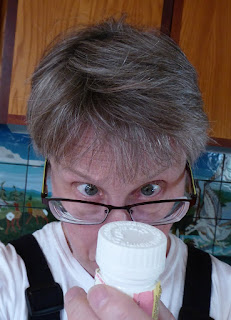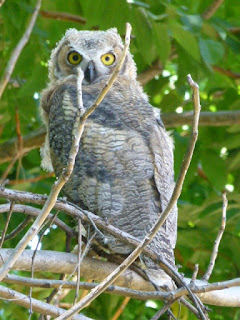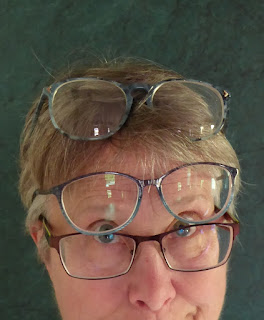 I accepted a lot of things about old people when I was a kid. Old people like Mrs. Peacock, my piano teacher. I accepted that she couldn’t get up from the piano bench without plooping out a soft, percussive fart. Everything was sort of loose on her, and that was just one more example. I accepted that neither of us was going to mention it. I did not get, however, why she always wore glasses but never looked through them. She looked over them, or under them.
I accepted a lot of things about old people when I was a kid. Old people like Mrs. Peacock, my piano teacher. I accepted that she couldn’t get up from the piano bench without plooping out a soft, percussive fart. Everything was sort of loose on her, and that was just one more example. I accepted that neither of us was going to mention it. I did not get, however, why she always wore glasses but never looked through them. She looked over them, or under them.
I did understand nearsightedness because I had a hot case of it myself. Nearsightedness and farsightedness are caused by the eyeball getting squished out of shape. Most people aren’t 20/20. Myopic people have long eyes–mine is shaped like a pickle now–and farsighted people have short tall eyes. You get long eyes when you have a very vivid imagination, because all your ideas get crammed in the front of your brain, where the weight of them presses down on the eyeballs. And your imagination gets ever more vivid because you can’t see anything and you turn inward. That’s why your vision gets worse over time. It’s a feedback loop.
 Lots of critters don’t have round eyes at all. Owls, for instance. They look nice and round from the front end, but they’re really shaped like buttons. Owls are tremendously farsighted and when things get too close they have to see them with their fuzzy feet, because they don’t have reading glasses, despite those pictures you might have seen that suggest otherwise.
Lots of critters don’t have round eyes at all. Owls, for instance. They look nice and round from the front end, but they’re really shaped like buttons. Owls are tremendously farsighted and when things get too close they have to see them with their fuzzy feet, because they don’t have reading glasses, despite those pictures you might have seen that suggest otherwise.
The entire eyeball phenomenon strikes a lot of people as having been too complicated to have merely evolved. They prefer to think eyeballs are proof that God whipped them out just as is, because they like to give God credit for almost everything except having an imagination. In fact, complex eyes have evolved a hundred times a hundred different ways, and pretty dang early on in the history of life, too.
 Anyway, people can develop near- or farsightedness in childhood, but the reading-glasses thing hits everyone sooner or later. Or, specifically, around age forty. This is when people are introduced to the notion of being old when various parts of them get stiff, or fail to get stiff, and the lens of the eyeball is one of the things that stiffens up. All of a sudden you have to hold your book further and further away from yourself to get it to come into focus, and by that time, assuming you haven’t run out of arm, it’s too small to read. Then those of us with glasses have to have our glasses ground two or three different ways. You might have book-reading focus on the bottom, computer-reading in the middle, and distance in the top. Works great for a while, and then you discover the book-reading lens isn’t really cutting it, and you start to look over your glasses and put your reading material right next to your nose.
Anyway, people can develop near- or farsightedness in childhood, but the reading-glasses thing hits everyone sooner or later. Or, specifically, around age forty. This is when people are introduced to the notion of being old when various parts of them get stiff, or fail to get stiff, and the lens of the eyeball is one of the things that stiffens up. All of a sudden you have to hold your book further and further away from yourself to get it to come into focus, and by that time, assuming you haven’t run out of arm, it’s too small to read. Then those of us with glasses have to have our glasses ground two or three different ways. You might have book-reading focus on the bottom, computer-reading in the middle, and distance in the top. Works great for a while, and then you discover the book-reading lens isn’t really cutting it, and you start to look over your glasses and put your reading material right next to your nose.
 Sometimes I have to look at something above me through the bottom portion of my glasses, which means I have to crunkle up my neck like an archaeopteryx. Poor old bird. That’s what did it in. Had to pretzel its neck just to navigate properly, and it lost all its aerodynamics.
Sometimes I have to look at something above me through the bottom portion of my glasses, which means I have to crunkle up my neck like an archaeopteryx. Poor old bird. That’s what did it in. Had to pretzel its neck just to navigate properly, and it lost all its aerodynamics.
Nothing in my glasses is exactly right for reading sheet music at the piano, so I have another pair of glasses just for that. And I need another pair for turning pages for someone else. Binoculars for distance. None at all for hand-sewing. I’m going to string them all on little jeweled chains and hang them from my neck and keep a lorgnette in my pocket so I can see which one I need next. That dangling collection of specs–that’s what’s really going to mark me as an old lady.
Unless I’m getting up from the piano bench at the time.
I'm glad I'm not the only one. I wear contacts during the day, which are multi-focal and I can see quite well at any distance. (Except I still need reading glasses to read the paper.) But once I pop the lenses out and wear my glasses… that's when the trouble begins. I have to take them off to read anything. It's really a problem if I'm watching a movie. I have to take them off to see the remote in my hand, lest I press the wrong button and go somewhere on the menu that I don't want to go. I've done THAT lots of times. Then I don't know how to get back to where I want to go, so I have to turn everything off and start over. But I have to have them ON to see the directions that are appearing on the screen. So I'm constantly pushing them up and down on my face. By the time I actually get the movie on the screen, I'm tempted to just say fuck it and go to bed with a book.
Oh, well, contacts: that's a whole other old-lady problem. I gave up on contacts. You see, eventually your eyeballs dry out. Lots of things dry out, but we'll just confine this thought to eyeballs for now.
I vaguely remember when waking up stiff in the morning was a good thing. Thanks for the eyeball explanation. It makes as much sense as any I've heard when my hearing is working, but that all changes several times a day.
What's that, junior? Speak up!
I am a card carrying member of the Long Eyeball Clan. I started on 'distance' glasses in fourth grade after the teacher caught me squinting at the blackboard. Graduated to contacts in my vain high school years. Now I don't wear glasses at all, since discovering that I don't need them. And at 65, I still don't need readers. I feel lucky. Now if I could just become a twenty something petite blond…
Right there with you, the fourth grade, the squinting, the vanity–but hey WHAT? You don't need them now?
I stopped wearing them when I drove, and found I didn't need them, except to read street signs (or at night, but I don't drive at night, much, so there's that…)and I usually Google map before I drive somewhere, so there's that…and for TV, I just like the fuzzy aspect, makes the actors look younger, (there's that) but I do wear them for watching tennis, because Rafa Nadal is gorgeous, and I like his details.
I recently saw an ad for a revolutionary new pair of reading glasses that folded up and could be tucked in a pocket or purse without taking up much room. Even came in a handy carrying case. Oh, did I mention this revolutionary idea was for a pair of pince-nez?
I'm all in except I don't want to shave the top of my head and go for the Ben Franklin mullet.
My husband has reading glasses like that. His has earpieces; they're not pince-nez. I can never fold them properly!!
Let's not forget the cost of the various pairs of glasses, too. Someone, somewhere, is getting rich off us old squinters.
This was a lot of fun, Murr! Especially the archaeopteryx bit, which rings very true for this ophthalmalogically challenged old person.
This gets into personal space issues too. I can no longer stand too close to another person I'm talking to because I can't get them in focus.
Everybody is copping to the eye issues, but not to the spontaneous dusting of crops when changing position. What's up with that? Must I always go first? ( second in this case…)
The deafness can come in handy here.
Back about 30+ years ago I began to have some difficulty reading small print.Like the telephone book.Went to an optician, a jolly young chap, who said:"Oh! It's a common problem in middle age.It's not your eyes so much as your short arms. Come through and we'll put you on the rack and stretch 'em a bit!"
Smack the sucker with your cane.
Sigh.
My distance vision is fine (I think). Close up I have a lot of trouble. I am pretty certain that labels are made impossibly small on purpose. Manufacturers don't want me to know what I am eating.
I don't want to know what I'm eating either.
This comment has been removed by the author.
You made me look up lorgnette!
It's a public service.
I'm long-sighted, which apparently means I have little imagination, so my distance vision is fine, but I'm also cross-eyed so need corrective lenses for that. Reading up close is a problem and reading at arm's length isn't possible because my vision goes past that and then there's the cross-eyed thing. It usually takes several trips back and forth tweaking any new lenses to the point where I can read books almost comfortably. The best thing I ever bought was prescription sunglasses and had them made bi-focal so I can read on the bus but still see where I'm going when I glance out the bus window, so I don't miss my stop.
You're going to be in the multi-jeweled-chain club.
A lot of the problem is print media. Phone books here now are impossibly small, so all the names and numbers are printed in miniature to fit them in, I can't read them even with a magnifying glass and newspapers are using less ink so the text is lighter in colour, only the headlines are regular strength ink and now look like they're done in "Bold", but even those are not as 'bold' as I remember headlines from childhood.
Not only that, but everybody mumbles these days.
Recently I parallel parked successfully and was so excited I posted it to Facebook. I'm legally blind in one eye so depth perception and I are not friends. I wear bifocals, too, for my "good" eye, so sister, I feel your pain. When I first got them, the optometrist warned me that it would mess up my depth perception. The man has a short memory. He's middle-aged, I'll forgive him. Oh and the farting thing? We could go on but I'll spare you. You're welcome.
Oh heck, you were just hitting your stride!
I just love following your brain around.
I could feel you behind me. I could.
Trifocals and reading glasses for now. Not looking forward to another specific pair.
Flip-down dark lenses, a dog, and a cane.
Great read. I had the tri-focals for a while, but noticed my golf game had gone. Never could get the ball in focus on the tee. Bought a pair of strictly distance glasses at one of the Wal stores and dropped 15 strokes off my game!
"I either need new glasses or a bigger club head." [Seldom-heard quotes]
Old fogey benefit to look forward to: cataract surgery! It transformed my terrible nearsightedness into all-around pretty good vision, just reading glasses for now.
Oh hey! I can only hope for that! Come on, cataracts!
Morels. I had to get a pair of glasses just to hold my own when we go mushroom hunting. I have readers, long-distance, and a pair that graduates from readers to distance up the lens. None of them worked for mushroom hunting, so that's another pair that I lug around.
Same lenses for newt-spotting?
I had a spectacular collection of reading glasses placed around my labs, before I retired. Now I just have them scattered around the house.
Where you can't find them.
Things get blurry for me around 6 ft and further away, so I often do not see peoples wrinkles unless they are close by or I have my glasses on.
A little distance helps most of us.
Thank you, your article is very good
viagra asli usa